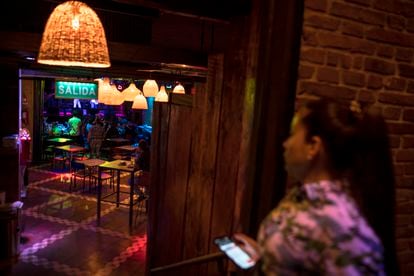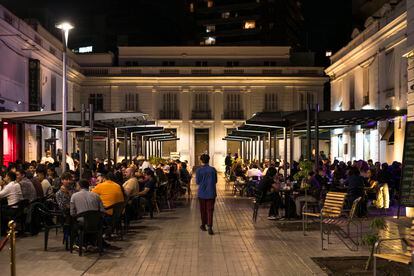Thursday, 11 pm. Natalia and Belén chat animatedly on the terrace of Bar Escondido, a traditional nightclub in a small alley in the heart of the Lastarria neighborhood, in downtown Santiago. The two friends, 39 years old, say that they don't go out much, that they prefer to get together at home and that tonight is an exception: they went to the theater and then decided to stop by for a drink. “I haven't gone out much for a while, since everything is closing very early and the city is a bit dangerous. So, it's not so nice to go out, I don't feel so comfortable,” says Natalia, sitting next to a bucket of champagne. “There is also an economic issue why one prioritizes staying at home. “Everything is very expensive,” adds Belén.
A few tables away, sitting next to the entrance to his establishment, Jaime Oyarzún, owner of the Hookah Troopa bar, says that the neighborhood has changed a lot. “Before it was much more on [animado]. People now arrive later and leave earlier. It influences that central Santiago is today considered one of the most dangerous communes in Chile. The economic stratum also fell. A friend told me the other day that he came to Lastarria for lunch and it was like being at Patronato [barrio tradicional de comercio ambulante en la vecina comuna de Recoleta]”, says.
In recent years, the neighborhood has seen several emblematic establishments disappear. The Italian Squadritto, the Berri bar and the Victorino, one of the most popular in the sector, closed their doors.
Some neighborhoods closed from seven in the afternoon
Santiago's nightlife has changed since the social outbreak of October 2019 and the pandemic that started at the beginning of 2020. It is a general feeling among those who live in the city, but while some, more enthusiastic, say that the night is returning to wake up, others believe he never recovered from the curfews and quarantines.
The main complaint is how early the bars and restaurants close. “Nighttime activity has been declining. There are certain neighborhoods in which, definitely, the activity ends at seven in the afternoon,” says Máximo Picallo, president of the Chilean Gastronomy Association, the union that brings together the main companies in the sector.
One explanation, he says, is that after the pandemic restaurants had to adapt their schedules and reduce their shifts, which prevents them from extending the day and closing later. “Many workers did not want to go back to working at night and that is why they close the kitchens earlier,” he says. Today it is common that between 10:00 and 11 at night many establishments no longer offer dishes and that, instead of closing their doors at three in the morning on weekends, as happened before, bars now open until one and a half”.
The insecurity of the city is another factor. “People are more reluctant to go out at night for fear of being mugged,” adds Picallo. He believes that a measure that could help revive nightlife would be for the Metro to close closer to two in the morning and not at 11 as it does now. And that the alcohol law be reviewed, which, in his opinion, “is quite outdated” and prevents a restaurant from having live music if it does not have a cabaret license or from people being able to dance in a bar if it does not have a license. disco patent.
Goodbye to the hustle and bustle, welcome to sleep
In Providencia, which in the 90s and 2000s was one of the epicenters of the reel –As Chileans call going out to party – the hustle and bustle, once abundant in the main artery of the commune, no longer exists today. At 10 pm on Thursday the streets look desolate, a few pedestrians walk quickly to catch an Uber or taxi or to enter the underground parking lot. The party here is concentrated in specific spots, where a few venues light up the atmosphere. The restaurant sector located in the vicinity of New Street in Lyon, where the Baco or Le Bistró restaurants are located, which previously remained open until at least one in the morning, today closes its doors at 11.
Further down, on the Orrego Luco promenade, there is more activity. It is nine o'clock and about 80 diners, most of them under 30 years old, are chatting animatedly at the tables arranged on the terraces of the different bars. Matías Vivar, manager of the emblematic Subterráneo bar and nightclub, says that in this corner of Santiago the party is still going. On weekends the Paseo opens its premises until two in the morning and the discotheque operates until four on Tuesdays and Wednesdays and until five on Thursdays, Fridays and Saturdays.

Walking further west, the General Flores neighborhood is emerging as a new nightlife hub. New bars have opened in recent months, focused on an older and more sophisticated audience. One of them is the Guachita snake. Located in an old house, its great advantage is the large terrace that opens onto the backyard covered by an old grapevine and the green bar that decorates the back of the garden. Bárbara Castellón, head of the bar, says that from Thursday to Saturday they close at two in the morning and her kitchen stays open until 12:45. She acknowledges, however, that she has seen a change in clients' behavior. “They arrive at eight and between 11:30 and 12 they ask for the bill and, from what one hears, they go home to sleep. It's not that they go out taxi (partying) later,” he says.
For Matías Rivas, director of Ediciones UDP and a keen observer of social phenomena, he believes that “during the pandemic, people realized what it meant to sleep deeply, they changed their relationship with sleep and that definitely changed their relationship with the night.” , says. “People spend their nights at home, watch Netflix marathons, order food and wake up early to climb hills. Go to bed early now or is it cap screw (nerd), it is an option,” he comments.
Added to that were crime and the economy, he adds. “It is very expensive to eat out and people don't understand the numbers. Before
, the night was the waste, but that night is now very small. Where do you go for tapas in Santiago? Bellavista (a traditional nightlife neighborhood in Providencia) is contaminated by crime, the night it was in Lastarria died, there is nothing in the center anymore. You no longer see a system of people flowing, unless they are from the street trade. Before, walking at night was a very common thing,” she points out.
Hidden parties and electronics
Andrea Ortega, urban planner, professor at the School of Architecture at the Diego Portales University (UDP), believes that the night has been regaining ground, but in a different way than before the pandemic. She agrees that now people prefer to stay up earlier and not stay up as late, but she says there are new interesting phenomena to observe.
“There are other types of night activities. For example, there are many hidden parties being held. It is a trend that occurs in other large cities and that is being replicated in Santiago,” he explains. Ortega mentions that other historical night spots in the Chilean capital are reinvented and do not go out of style. This is the case of Blondie, the nightclub that opened its doors 30 years ago and established itself as a place of worship among the under Santiago at the end of the 90s. Today, despite being in the middle of Alameda, adjacent to neighborhoods considered dangerous, it continues to attract an important part of Santiago's bohemia that is looking for a place to dance.
Ariel Núñez, its general producer, says that they receive up to 1,000 people a night and that, although the usual patrons continue to come, the public that rules today is those aged 30 or younger. “And I would tell you that music changed in three years. Before the pandemic the icon was Madonna and Dua Lipa appeared,” he says.

Lower profile and like a secret that is passed by word of mouth, the electronic scene is making its entrance in the capital of Santiago. The journalist and DJ Nico Díaz, who together with the photographer Pepo Fernández form the duo Aerobica, began to produce their own traveling parties between 2017 and 2018 in different places in Santiago. The majority between the central communes of Quinta Normal, Independencia and Recoleta. “The change was radical between what was happening before the pandemic and after. And it has taken unexpected turns. When everything began to open, a fervor was generated that I had not seen before,” he says. In Santiago, he says, “an industry has proliferated that operates very quietly, with very prohibitive legislation, but that is having a regional and global impact, bringing artists and going to play elsewhere,” he says.
It is a reality that, in his opinion, contrasts with how dull the city is in the most consolidated places. “Everything closes at 10 or 11 at night, the city shuts down very early. Many times these restrictive conditions end up generating a very powerful countercultural movement. Today there are many parties underground happening, some with up to 2,000 people, but even so Santiago is not a city that never sleeps. On the contrary, he sleeps a lot,” he says.
Subscribe here to the EL PAÍS Chile newsletter and receive all the key information on current events in the country.
#night #Santiago #wake #economy #insecurity #habits #turn #nightlife